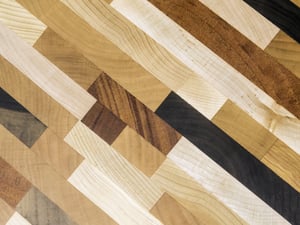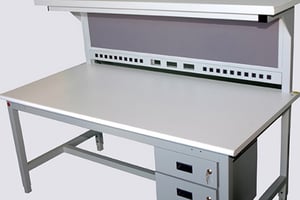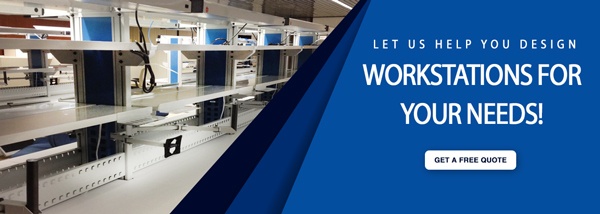Industrial workstations must be able to withstand harsh environments. The material you choose for your workstation top can have long-lasting ramifications if it cannot withstand its environment.
While many companies cite budget as one of the biggest factors in their decision-making, it’s important not to choose a surface that can’t hold up to the conditions surrounding it simply to save a few bucks. In reality, in the long run, you’ll end up spending more since you will likely have to replace the materials sooner.
Assembly workstations, in particular, can feature a wide range of materials. While one material may be appropriate in one manufacturing assembly workstation, that same material in another may be subject to damage easily.
Here are some of the best materials for manufacturing assembly workstations, and what help is available to assist you in determining which one is best for your environment.
Butcher Block
 Butcher block is one of the most common materials found in manufacturing assembly workstations, If the environment is free from harsh conditions.
Butcher block is one of the most common materials found in manufacturing assembly workstations, If the environment is free from harsh conditions.
This material is used to construct countertops for industrial settings because of its strength and durability. They are especially popular in woodworking and basic assembly applications, but can be used in food prep areas as long as the material is sealed beforehand to prevent liquids from seeping into porous areas.
For assembly workstations that require sanitary conditions, hard maple wood - which is often used to construct butcher block - offers antibacterial properties.
However, if your manufacturing assembly workstation is in an environment where its materials may be subject to harsh conditions, butcher block may not be the best choice. For example, excessive heat can cause warping, while an excessive amount of water or humidity can cause a buildup of mold and germs.
Butcher block is also extremely vulnerable to dents and scratches, so if you use heavy equipment as part of your assembly, it may be wise to choose another more durable material.
ESD Laminate
Static electricity can be a big problem, especially in electronic parts assembly operations. This can impact not only the product, but the production process and worker safety.
If your assembly workbenches and workstations involve weighing parts or must adhere to certain clean room specifications, static electricity can interfere with the accuracy of these measurements or conditions.
Countertops on manufacturing assembly workstations can be constructed to minimize static electricity. However, when determining which material you should choose, you will want to consider that particular material’s resistance to substances you commonly work with in your environment.
In particular, ESD Laminate is a great material to use in applications where parts and materials that are sensitive to static are being assembled.
However, be prepared to pay more for this type of material. ESD Laminate can cost anywhere between 15 to 30% more than a non-ESD product. It’s also important to note that if assembly equipment damages the laminate, the ESD protection may be compromised.
High Pressure Laminate
 Although the above two materials are commonly used in assembly workstations, there are several other materials as well that work well in this type of manufacturing environment.
Although the above two materials are commonly used in assembly workstations, there are several other materials as well that work well in this type of manufacturing environment.
One of the most economical choices, high pressure laminate (HPL) offers a durable surface, but like butcher block, requires an environment without extreme applications. Decorative options are also available with this type of material, making it a favorite in locations where aesthetics are important.
HPL laminate can also withstand some heat, though the threshold is about 275 degrees for suspended periods of time.
Other Material Types
If your assembly involves use of chemicals, chemical resistant laminate may make the most sense for your operation. This type of material, however, doesn’t hold up well against other extreme conditions like bacteria, moisture and scratches.
Epoxy resin, though one of the most expensive options, is durable and holds up well in laboratory workstations that also include industrial testing areas. That’s because this material is highly resistant to bacteria, chemicals, fungus, corrosion and moisture, as well as high heat and stress fractures.
Epoxy resin can also withstand exposure to flames, whereas another type of material, phenolic resin, cannot. If open flames are not a concern in your manufacturing assembly workstation, phenolic resin may be a more cost-effective solution because it still retains the same high resistance to harsh environments as epoxy resin, but is mid-price when it comes to material costs.
Bottom Line
Though you may have some idea of what material would work best for your manufacturing assembly workstation, a high-quality industrial furniture manufacturer can assist you with determining whether it is the right long-term choice.
A manufacturer will address any concerns you have regarding your budget, as well as examine what areas of concern your application and environment may pose.
Perhaps most important to your project, the best manufacturers will work with you to streamline the process and ensure you receive your materials in a timely manner so that you can move forward with your assembly production.


